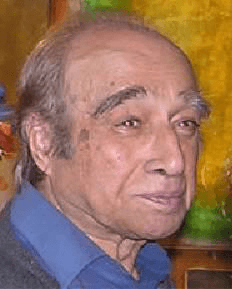Ismail Gulgee facts for kids
Quick facts for kids
Gulgee
گل جی |
|
|---|---|
 |
|
| Born |
Ismail Gulgee
25 October 1926 |
| Died | 16 December 2007 (aged 81) Karachi, Pakistan
|
| Resting place | Imam Muslim Cemetery, Karachi |
| Nationality | Pakistani |
| Education |
|
| Known for | Islamic calligraphy, Painting, Sculptures |
| Movement | Islamic calligraphy |
| Spouse(s) | Zareen Gulgee |
| Awards |
|
Ismail Gulgee (Urdu: امین اسماعیل گل جی; 25 October 1926 – 16 December 2007), known simply as Gulgee, was a famous Pakistani painter. He was born in Peshawar and became known for his unique art style.
Gulgee first painted portraits of people. Later, he moved on to abstract art. His abstract works were inspired by beautiful Islamic calligraphy. He became famous around the world. Many important leaders asked him to paint their portraits. These included US Presidents Jimmy Carter and George H. W. Bush. He also painted the Shah of Iran and King Hussein of Jordan. Sadly, Gulgee passed away on December 16, 2007, in a tragic incident.
Contents
Gulgee's Early Life and Schooling
Gulgee was born on October 25, 1926. His birthplace was a place called Karimpura in Peshawar, Pakistan. For his early education, he went to Lawrence College Murree.
He then studied civil engineering at Aligarh University. After that, he traveled to the United States for more studies. While he was an engineering student at Columbia University, he started to paint. Gulgee also studied at Harvard University.
Gulgee's Unique Painting Style
Before 1959, Gulgee was a portrait painter. He even painted the entire Afghan Royal Family. In the early 1960s, he began painting in an abstract style.
Gulgee was very good at painting realistic portraits. However, he became most famous for his abstract art. This art was inspired by Islamic calligraphy. It also showed influences from a style called "action painting" from the 1950s and 1960s. Some people believe that Elaine Hamilton influenced his work.
Both Islamic calligraphy and action painting focus on strong, flowing movements. Gulgee's paintings were often very large. He sometimes added materials like mirror glass, gold, or silver leaf to his oil paintings. This made them look like mixed media art.
The Metropolitan Museum of Art describes his work. They say Gulgee's calligraphy paintings are abstract. They show his artistic take on Arabic and Urdu letters. His layers of paint explore the qualities of oil paint. They also connect to Islamic design.
Starting in the 1960s, Gulgee also created sculptures. Many of these were bronze pieces. Like his paintings, they were inspired by calligraphy. Some were even based on verses from the Quran. Gulgee's son, Amin Gulgee, is also a well-known artist.
International Art Assignments
Gulgee's paintings were highly sought after around the world. He received many requests for his art. Important people, from the Saudi royal family to the President of Pakistan, wanted his works. Many of his paintings are displayed in the Faisal Mosque in Islamabad.
Art Exhibitions and Gallery
Gulgee held his very first painting exhibition in 1950. His art shows were often for a select group of people.
Because many people wanted to see his work, an art gallery for Gulgee was built. It is located in Clifton, Karachi, near South City Hospital and Sea View Karachi. Gulgee mostly painted for his own artistic vision. However, some of his selected paintings are shown at the Clifton Art Gallery.
Awards and Recognition
Gulgee received several important awards for his contributions to art:
- Pride of Performance Award in 1970 from the President of Pakistan.
- Sitara-e-Imtiaz (Star of Excellence) Award in 1982 from the Government of Pakistan.
- Hilal-e-Imtiaz (Crescent of Excellence) Award in 1995 from the President of Pakistan.
See also
 In Spanish: Ismail Gulgee para niños
In Spanish: Ismail Gulgee para niños
- Islamic calligraphy (a key inspiration for Gulgee's abstract art)
- Action painting (a style that influenced his work)
- Elaine Hamilton (an American painter who influenced Gulgee)
- Mixed media (art that uses different materials)
- Abstract expressionism (a type of abstract art)

